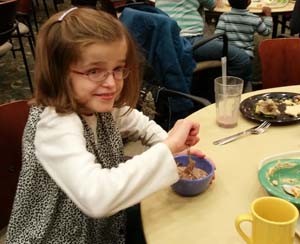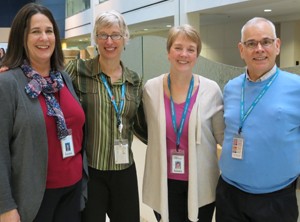
Last April, at the age of 12, Lydia Vaughan felt hungry for the first time.
The new sensation – along with support from her family and a team of specialists at Seattle Children’s – helped her learn to do in two weeks what she had never done before: put food in her mouth and swallow it.
It was a victory for Lydia, who was born with a constellation of medical problems that made eating by mouth both dangerous and painful. At 1 month of age, surgeons at Children’s implanted a gastronomy tube, which allowed her to receive nutritious formula directly into her stomach. The feeding tube saved Lydia’s life and helped her grow and thrive. But when Lydia became physically capable of eating, she refused to put anything in her mouth – past experiences had taught her that swallowing and eating equaled pain.
Her grandparents and guardians, Arlene and Dave Johnson, tried everything they could to get her to eat – encouraging, cajoling and patiently pushing spoons of enticing tidbits toward her mouth. Lydia would go as far as licking a chip or letting yogurt touch her lips, but she didn’t come close to eating enough calories to keep her alive.
Finally, Arlene and Dave – frustrated and afraid that Lydia would never learn to feed herself – turned to the Intensive Feeding Program at Children’s for help. They knew it would require them to do something that goes against every parental instinct: let their child go hungry. But they also knew they wouldn’t be alone.
Recognizing an empty stomach
“Even when the medical problem that made a feeding tube necessary has resolved, kids often have a lot of fear and anxiety around eating – and so do their families,” says Karen Quinn-Shea, an occupational therapist who has been an integral part of the program since it started in 2003. “It’s not unusual for kids to become hyper-vigilant and averse to food.”
Breaking through the barrier and getting the child’s buy-in is key to the program’s success. And that takes time, energy, patience, support – and hunger, she says.
“Many programs in the U.S. use a strictly behavioral approach to getting kids to eat,” says Quinn-Shea. “Ours is one of a very few based on creating hunger and teaching kids how to recognize their hunger cues.”

In addition to Quinn-Shea, the Intensive Feeding Program team includes a second occupational therapist, Peggy Smith; nutritionist Kim Cooperman; developmental pediatrician Dr. Timothy Brei; and a social worker. During the two-week outpatient program, patients are monitored for weight and vital signs, and the team troubleshoots any concerns that arise.
Children often lose weight at the beginning of the program, which is tough for parents who have spent years vigilantly making sure their child’s nutritional needs are met.
When that happens, the more trained eyes on the patient, the better, says Arlene. “When we dropped back on Lydia’s tube feeding, I needed to know that someone was monitoring her and paying attention to how her body was responding,” she says. “That’s something we just couldn’t do on our own.”
Breakfast, lunch, snack, repeat
To take part in the program, families need to step away from their everyday lives for two weeks and commit to eating breakfast, lunch and an afternoon snack at Children’s with Quinn-Shea or Smith. Meals take place in the hospital’s Eat Well, Be Well Room, which is designed to look like a home kitchen.
By the time families arrive on the first day, they’ve already cut back tube feedings, and the child is getting just 20% of their normal nutritional intake. They’re hungry, but they don’t recognize it as hunger or know what to do about it. The team ensures children stay well hydrated, and water is given through the feeding tube as needed.
During eating sessions that feel more like family meals than therapy, Quinn-Shea and Smith work one-on-one to help children understand and manage the sensation.
“The first week is about creating enjoyable, no-pressure mealtimes, but children typically don’t eat much right away,” says Quinn-Shea. The child continues to get some of their nutritional needs met through tube feeding – enough to keep them safe, but not enough to cancel out the hunger cues.
Things usually pick up the second week. “There’s an excitement when your child eats a bite or two of yogurt, then an ounce,” says Quinn-Shea.
For Lydia’s family, a high point came during the second week, after Dave noticed that Lydia liked peanut butter and chocolate syrup. He ran out to get a Reese’s Peanut Butter Cup, and everyone in the room watched Lydia take a bite. “She lit up like a Christmas tree!” says Arlene.
The program serves just two families each month and works with patients who are 1 year and older. Because demand for this tiny program is so high, it only accepts families from the Washington-Alaska-Montana-Idaho region.
It’s not over when the kids go home
“The goal of the program isn’t for kids to be finished with feeding tubes in two weeks, but to help them get past their fear of eating and start to experience its joys,” says Quinn-Shea.
By the end of the program, most kids are taking about half their calories by mouth, and about 15% are taking all their calories by mouth. Many children, like Lydia, find drinking more challenging than eating and continue to need water through the tube for months after they return home.
“Learning to eat has been great for Lydia’s confidence,” says Arlene.
After the program, she was able to eat with her classmates in the school lunchroom for the first time. At Thanksgiving, Lydia had her first taste of the family feast and ate stuffing, potatoes and cranberry sauce.
The family has follow-up visits with the Intensive Feeding Program to monitor Lydia’s progress, and they know the team is just a phone call away if questions come up.
“There was a time when I thought Lydia would never be able to eat by mouth,” says Arlene. “Now she can go into a restaurant and have something delivered just to her – it makes her so proud.”
For more information or to reach the Nutrition team, call 206-987-2613.

